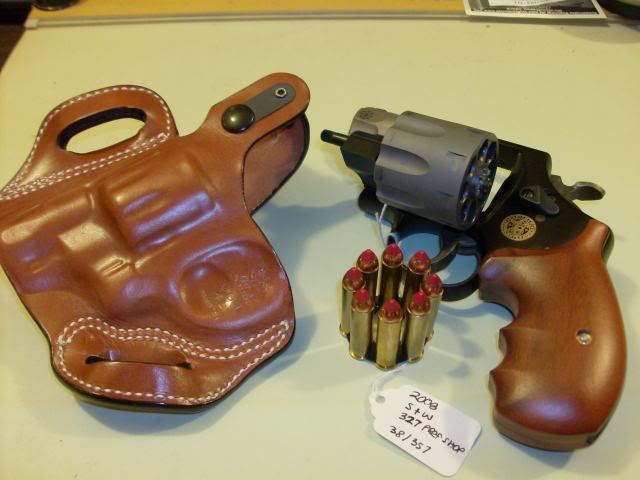While capacity is certainly an attribute that should be carefully considered, it is not necessarily the most important attribute when selecting a defensive handgun. For example, my own circumstances dictate that I'm much more likely to be facing one or two very large individuals at very close range than I am a smaller group of average sized individuals at a more extended range. Because of this, the handgun that best fits my needs is one that can fire a powerful cartridge, be very reliable at short distances (including contact distance), be difficult to take away from me should I wind up grappling for the gun, and offer a size-efficient package. The handgun that best accomplishes all of these goals is a revolver chambered for a cartridge no smaller than .357 Magnum with a barrel no more than 4".
Now, I realize that a high-capacity semi-automatic would better prepare me for a situation in which I was faced with 3 or more individuals, but it would, in my mind, be the inferior choice for 1-2 very large individuals because it does not meet the above-mentioned goals as well as a revolver does. While a larger group of assailants is always a possibility, I find it more prudent to be optimally prepared for one or two very large individuals as that is the far more likely scenario for me to find myself in. That being said, when circumstances change such as when I have to travel to a sketchy part of a large city, I often carry a high-capacity semi-auto either as a replacement for or in addition to a revolver.
While it's not optimum, I do not feel that I'm completely unprepared for a multiple-attacker situation if armed only with a revolver. As I mentioned in a previous post, I always carry at least one reload regardless of the type of gun or capacity. Even if I should find myself in the "worst case" multiple-attacker situation in which I'm faced with multiple people who are armed and willing to brave gunfire in order to achive their goal, I'm certainly not going to stand still blazing away like Wild Bill in the streets of Deadwood or some other such nonsense. At first opportunity, I will seek cover and/or retreat thus giving me more time to reload and/or seek a better weapon if necessary. Likewise, even if faced with a determined adversary, it is an extremely rare person who will not at least duck or seek cover when someone starts shooting at him, particularly if gunfire is an unexpected reaction. Such a reaction will serve to increase the time and distance that I have to take the necessary action.
As to revolvers "evolving," they certainly are evolving into bigger and more powerful guns geared towards hunting, but they're also evolving into small and easily carried guns aimed at concealed carry as well. Some of the most popular revolvers on the market right now are small light, and eaisly carried such as the S&W 642, S&W BG38, and Ruger LCR. While many first-time gun buyers tend to gravitate towards the high-capacity "tactical" semi-auto, many of them soon learn that a dozen or more rounds is heavy and that the gun required to hold them is fairly large. Once that realization is made, smaller more easily carried guns including snub revolvers become very appealing very quickly.
In the arena of a pocket gun, I've found no type that works better than a small revolver. In order to get a semi-auto as small or smaller and as easily or more easily carried as a J-Frame or similarly sized revolver, you have to go one of two routes. The first route is the more tradtional approach of selecting a semi-auto in a small caliber such as .25 Auto, .32 Auto, or .380 Auto. While a good quality gun of this type can certainly work fine, the cartridge leaves something to be desired when compared to those avialable in a small revolver such as .38 Special or .357 Magnum.
The other (and increasing popular) option is with a "subcompact" 9mm or .40 S&W like the Ruger LC9, Walther PPS, or Glock 26. While these guns certainly fire a more potent cartridge, they also have smaller and lighter slides and grips which makes them more prone to malfunction than their full-sized counterparts. Now, I'm aware that many people own and carry subcompacts that have been very reliable, and that's great, but my own experience with subcompact semi's has not been nearly so glowing. It has been my experience that subcompact semi's are much more finicky about things like grip and ammunition. Revolvers, on the other hand, seem to be much more tolerant of miniaturization. The only reliability issue I'm aware of that is endemic to small revolvers and not large ones is bullets jumping crimp in extremely lightweight guns chambered for very powerful cartridges (exotic metal guns chambered for magnum cartridges seem to be the worst offenders).
Now, all of this being said, a tiny handgun is almost never the best choice for a novice and revolvers are no exception to this. Small handguns are inherently more difficult to shoot well because they have shorter sight radii, more pronounced recoil, and often heavier triggers. While a medium or large frame handgun is usually the best choice for a new shooter, I do think that a small revolver is a better choice for a novice than a subcompact semi-auto due to reliability and simplicity of use.

